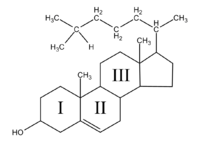
Hopanoids
Encyclopedia


Hopane
Hopane is a natural chemical compound classified as a triterpene. It forms the central core of a variety of other chemical compounds which are collectively known as hopanoids....
. Their primary function is to improve plasma membrane strength and rigidity in bacteria
Bacteria
Bacteria are a large domain of prokaryotic microorganisms. Typically a few micrometres in length, bacteria have a wide range of shapes, ranging from spheres to rods and spirals...
. In eukaryotes (including humans) cholesterol
Cholesterol
Cholesterol is a complex isoprenoid. Specifically, it is a waxy steroid of fat that is produced in the liver or intestines. It is used to produce hormones and cell membranes and is transported in the blood plasma of all mammals. It is an essential structural component of mammalian cell membranes...
serves a similar function. This relationship between biochemical structure and cellular function can be seen in the similarity of the basic structures of diploptene, a hopanoid compound found in some prokaryotic cell membranes, and cholesterol, a sterol compound found in eukaryotic membranes (I, II, and III in images at right).
In many bacteria hopanoids may play important roles in the adjustment of cell membrane permeability and adaptation to extreme environmental conditions. They are formed in the aerial hyphae—spore bearing structures—of the prokaryotic soil bacteria Streptomyces
Streptomyces
Streptomyces is the largest genus of Actinobacteria and the type genus of the family Streptomycetaceae. Over 500 species of Streptomyces bacteria have been described. As with the other Actinobacteria, streptomycetes are gram-positive, and have genomes with high guanine and cytosine content...
, where they are thought to minimise water loss across the membrane to the air. This is a physiological adaptation not faced by most bacteria which mainly live in water, but similar adaptations are needed by eukaryotic fungi that produce aerial spore bearing hyphae.
In the ethanol fermenting
Ethanol fermentation
Ethanol fermentation, also referred to as alcoholic fermentation, is a biological process in which sugars such as glucose, fructose, and sucrose are converted into cellular energy and thereby produce ethanol and carbon dioxide as metabolic waste products...
bacterium Zymomonas mobilis
Zymomonas mobilis
Zymomonas mobilis is a bacterium belonging to the genus Zymomonas. It is notable for its bioethanol-producing capabilities, which surpass yeast in some aspects. It was originally isolated from alcoholic beverages like the African palm wine, the Mexican pulque, and also as a contaminant of cider and...
hopanoids may have a role in adaptation of cell membranes to ethanol accumulation and to temperature changes which influence membrane functions. In the actinomycete Frankia
Frankia
Frankia is a genus of nitrogen fixing, filamentous bacteria that live in symbiosis with actinorhizal plants, similar to the Rhizobia bacteria that are found in the root nodules of legumes in the Fabaceae family. Bacteria of this genus also form root nodules.The genus Frankia was originally named by...
, the hopanoids in diazovesicle membranes likely restrict the entry of oxygen
Oxygen
Oxygen is the element with atomic number 8 and represented by the symbol O. Its name derives from the Greek roots ὀξύς and -γενής , because at the time of naming, it was mistakenly thought that all acids required oxygen in their composition...
by making the lipid bilayer
Lipid bilayer
The lipid bilayer is a thin membrane made of two layers of lipid molecules. These membranes are flat sheets that form a continuous barrier around cells. The cell membrane of almost all living organisms and many viruses are made of a lipid bilayer, as are the membranes surrounding the cell nucleus...
more tight and compact.
A range of hopanoids are found in petroleum reservoirs, where they are used as biological markers.
Hopanoids in paleobiology
Hopanoids, including 2-alpha-methylhopanes from photosynthetic bacteria (cyanobacteria), were discovered by Roger Summons and colleagues as molecular fossils preserved in 2.7 GyaGya
In astronomy, geology, and paleontology, Gya or Ga is a year multiplied by one of the SI prefix multipliers. It is often used as a unit of time to denote length of time before the present...
shales
Shalës
Shalës is a municipality in the Elbasan District, Elbasan County, central Albania. The municipality consists of the villages Shalës, Licaj, Kurtalli, Xibrake, Xherie and Kodras....
from the Pilbara, Australia
Australia
Australia , officially the Commonwealth of Australia, is a country in the Southern Hemisphere comprising the mainland of the Australian continent, the island of Tasmania, and numerous smaller islands in the Indian and Pacific Oceans. It is the world's sixth-largest country by total area...
. The presence of abundant 2-alpha-methylhopanes preserved in these shales may indicate that oxygenic photosynthesis evolved 2.7 Gya, well before the atmosphere became oxidizing. However Fischer et al. have demonstrated that Geobacter sulfurreducens can synthesize diverse hopanols, although not 2-methyl-hopanols, when grown under strictly anaerobic conditions. Archean
Archean
The Archean , also spelled Archeozoic or Archæozoic) is a geologic eon before the Paleoproterozoic Era of the Proterozoic Eon, before 2.5 Ga ago. Instead of being based on stratigraphy, this date is defined chronometrically...
2-methyl-hopanes also might have been produced by ancestral cyanobacteria that predated oxygenic photosynthesis.
Andrew H. Knoll, in Life on a Young Planet (2003), especially in Chapter 6, The Oxygen Revolution, has an authoritative and very readable account of the usefulness of hopanoid molecular fossil biomarkers in reconstruction of early evolution and geology.

